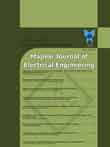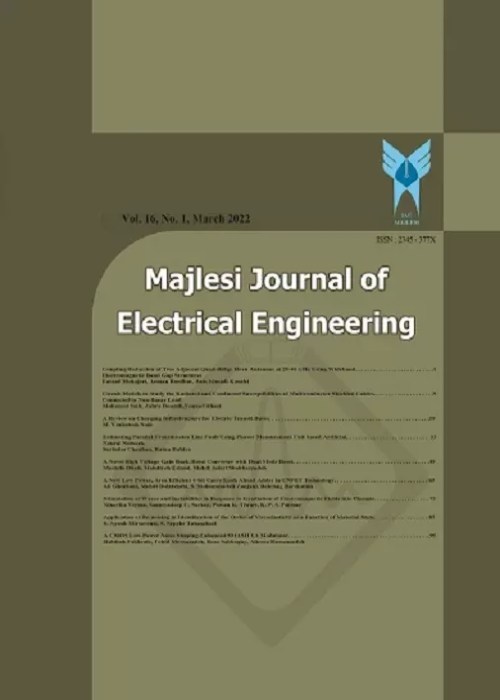فهرست مطالب

Majlesi Journal of Electrical Engineering
Volume:10 Issue: 2, Jun 2016
- تاریخ انتشار: 1395/04/29
- تعداد عناوین: 7
-
Page 1This paper introduces a novel ultra-wideband (UWB) microstrip antenna having wireless local area network band rejection characteristics. The proposed antenna is composed of a lip-shaped radiation patch being fed by a 50 Ω coplanar waveguide (CPW) feed line. The ground vertically continued to the two sides of the radiator. Thus, the substantial extra space adjacent to the radiator can be efficiently saved. The band rejection in the wireless local area networks (WLAN) (5.15-5.825GHz) is secured through etching the two symmetric C-shaped slots on ground plane to preclude interference between UWB and WLAN systems. The proposed antenna is of the size of 30×30×1.6 working within the range of 2.96 to 11.2 GHz with VSWR lower than 2 except in 5.15-5.825GHz band. Finally, the antenna is simulated and fabricated with nearly omnidirectional radiation patterns, stable gain and constant group delay in the operating band.Keywords: Ultra wideband (UWB), Coplanar waveguide (CPW), Microstrip antenna, wireless local area network (WLAN), Voltage standing wave ratio (VSWR)
-
Page 9The series robot is a type of the mechanical arms with a function similar to human hands which is usually programmable. These robots, depending on the application, are designed in order to perform various operations such as clinch, welding, packaging, assembly and etc. One of the most important issues in the field of the series robots that has been highly regarded in the past few decades, is the path control. Various industries have urgent and serious need to know the optimal control of path. In this paper, the design and implementation of a series robot with two degrees of freedom and its fuzzy control is studied. This fuzzy controller, is an approach to optimal control of robot path. In these robots, finding the optimal path would be time consuming. This study uses fuzzy logic and the laws governing it, which will result the most efficient path in very little time. Then, how to use and implement Fuzzy toolbox in MATLAB software will be discussed. Evaluation of the results show that the proposed model has a higher rate than other existing models, in the field of the optimal control of robot path.Keywords: Fuzzy Logic, Mechanical Arm, Optimization, Series Robot
-
Page 17A photovoltaic (PV) power generation system under partial shaded conditions (PSC) exhibits multiple power peaks in the power-voltage (P-V) characteristic curve and traditional optimization methods fail to detect the global maximum power point (GMPP). This paper proposes a hybrid intelligent to improve the maximum power point (MPP) tracking capability for PV system under partial shading condition. The key advantage of the proposed technique is the elimination of PI control loops using direct duty cycle control method. Furthermore, since the proposed method is based on optimized search method, it overcomes the common drawback of the conventional MPPT, i.e. To evaluate the idea, the algorithm is implemented on a boost converter and compared to the conventional MPPT methods. Simulation results indicate that the proposed method outperforms others method in terms of global peak (GP) tracking speed and accuracy under various partial shading conditions. Furthermore, it is tested using data of a tropical cloudy day, which includes rapid movement of the passing clouds and partial shading.Keywords: Optimization, Photovolotaic power systems, DC, DC power convertors
-
Page 27Nowadays, compared to the past, the growth of technology in suspension systems have led the magnetic bearings to a more powerful and economical design. Such bearings proved to have lots of benefits such as performance capability in high speeds and the ability to perform action without lubrication in different performances. That cause a decrease in the environmental and system pollution and makes it possible to work in vacant environments. Such bearings which work without friction show to have little attrition. In This paper, investigates the operation of magnetic bearing having 8 and 16 polar at a velocity rate at 30000 rpm and gap tolerance ranging from 2 to 0.5 mm. The magnetic for condition simulates based on finite element by optimizing the best mesh measurement.Keywords: Control, process, Magnetic bearing, Finite element, Optimization, Meshing
-
Page 31In Iran because of the existence of Competitive market for power production, the existence of competitors in the national and international market and the policies of ministry of Power production in producing the market for producing power with the least cost, it is urgent to determine exactly the cost of power production. The first step in this regard would be to compute the cost of power production within the power station, thus it would be necessary to determine the cost of different ways in which power is produced. This would provide managers with the tools for controlling and supervising power costs and plans.
In this paper, the cost of power production in the combined cycle power plant for the case Shahid Kaveh power plant of Ghaenat city will be examined. Then the cost of power production in a CHP power plant for the case of CHP power plant in Gonabad belonging to Sanat Yaran Energy Fadak Ghadr has been studied. Eventually, comparing power production costs in combined Cycle Power Plant with CHP power plant, it has been concluded that a CHP power plant is superior to a combined Cycle Power Plant in efficiency, power tolls, power quality and etc.Keywords: The cost of electricity, costs, CHP, Gas power plant -
Page 39The main contribution of this paper is proposing a novel deterministic and non-iterative clustering algorithm for automatic Farsi license plate recognition (ALPR). In fact, after discarding some regions with low probability in terms of being license plate, the edge points inside every separately remained region are considered as a cluster and a Gaussian component is estimated using expectation-maximization (E-M) algorithm, for every cluster. Candidate regions are obtained by applying application-oriented thresholds for size, aspect ratio and orientation to Gaussian components. Then the license plate regions are identified by counting regions like to numeric characters, exploiting maximally stable extremal regions (MSER) detector whereas numeric characters are extracted by using a proposed algorithm, for discarding non-character regions. So, the algorithm is able to segment the license plate numeric and alphabetic characters simultaneously. Finally for character recognition, a new simple, fast and robust algorithm, which uses feature extraction and template matching technique, is proposed. The method is evaluated for detection and recognition, by using an Iranian image database that includes access control (AC), law enforcement (LE) and road patrol (RP) applications. The method is robust to rotation, skew, and multiplicity of license plate and low quality and complex background images.Keywords: License plate recognition, law enforcement, OCR, Deterministic clustering algorithm
-
Page 53The topic of power allocation in MIMO systems for wireless communication in order to reach high capacity or low bit error rate has gained some attention. In this paper, heuristic algorithms, including genetic and particle swarm optimization algorithms, are applied to find the optimal power allocation for achieving best capacity benefit. Two cases of un-polarized and cross-polarized antennas of spatial MIMO channel modeling are studied. We demonstrate that the performance of genetic and particle swarm optimization algorithms is optimal compared with a perfect search at a reduced computational complexity. These algorithms have fast convergence and can handle large number of sub-channels without performance degradation. Both simulation and numerical results confirm that, compared to other mathematical methods, the proposed algorithms are more efficient in terms of complexity and power assignment to antennas in a MIMO system.Keywords: MIMO systems, channel capacity, genetic algorithm, particle swarm optimization algorithm, cross, polarized antennas, spatial channel model


